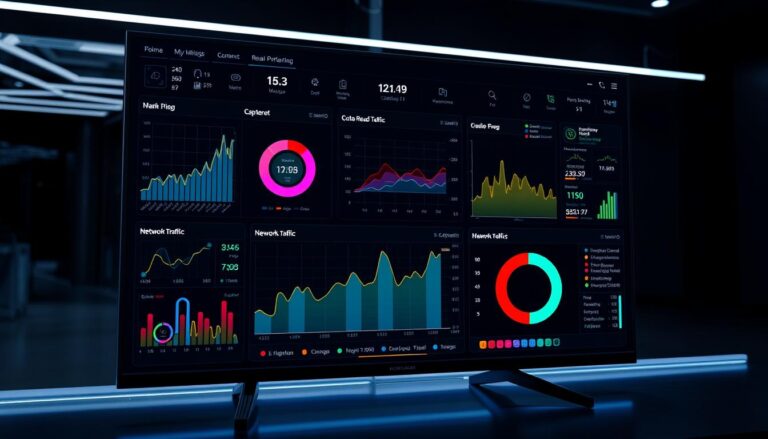In today’s world, making smart decisions is key for business success. This makes using a custom predictive analytics tool very important. With 2024 approaching, the IT Services market is expected to hit US$1,364.00 billion in revenue. This shows how crucial predictive data systems have become.
Custom software for predictive analytics is changing the game by offering unique tools to U.S. companies. This demand shows these tools are becoming more popular. The global market for predictive analytics is predicted to grow at a 14.4% rate from 2020 to 2027.
Companies like Netflix and Spotify show how these tools work by customizing content for users. This really helps keep users interested. They use advanced analytics techniques like Regression Analysis and Neural Networks. Such techniques help businesses predict customer behavior and manage inventory better.
Getting into predictive analytics for your business involves some costs, starting around $15,000. But this investment helps your company in many ways. It improves forecasting in logistics and credit scoring in fintech, among others.
Key Takeaways
- The IT Services market is booming, indicating a ripe environment for investing in custom predictive analytics.
- A personalized analytics software solution is essential in adapting to the rapid growth of the predictive analytics market.
- Services like Netflix provide a benchmark of how predictive data modeling can revolutionize user experience and satisfaction.
- From fraud detection in fintech to predictive maintenance in manufacturing, the applications of bespoke tools are diverse and industry-specific.
- Predictive analytics is a significant factor in customer retention strategies and operational optimizations in multiple sectors.
- The entry cost for predictive analytics projects is substantial but justified by the potential return on investment through insights gained.
- Innovative predictive analytics solutions are crafted to align with the compliance and data privacy framework, maintaining user trust and legal integrity.
Understanding Predictive Analytics and Its Importance
Predictive analytics changes raw data into useful insights. This lets organizations see future possibilities. With advanced analytics software, it’s easier to plan and make decisions. This method uses statistical algorithms and machine learning. It helps a lot in business analytics and planning strategies. Predictive analytics does more than guess future events. It gives a probability estimate to help with proactive decisions.
Using predictive modeling software boosts how well businesses run. It also lowers risks and raises earnings. This is very important in today’s data-driven world. Having an edge and being efficient are key to success.
What is Predictive Analytics?
Predictive analytics is technology that forecasts the future. It looks at past and present data to predict what might happen next. It goes through steps like gathering data, getting it ready, and using statistical and machine learning models. Tools like SAS Advanced Analytics, IBM SPSS Statistics, and Python’s scikit-learn are common. They are great for dealing with big data and for things like regression analysis and time series forecasting.
Benefits of Predictive Analytics in Business
With predictive analytics, companies can foresee trends and make better decisions. It helps in many ways, like managing risks better and improving customer service. In manufacturing, IoT data analytics predicts when machines need maintenance. This reduces downtime. And in retail, it forecasts stock needs. This makes supply match with predicted demand.
Key Industries Leveraging Predictive Analytics
Many industries use predictive analytics to grow and innovate. Healthcare uses it for better patient care management. Banks use it for credit scoring and catching fraud, which builds trust. Retailers use insights to improve marketing, manage inventory, and make shopping better for customers. This keeps them competitive and profitable as markets change. Predictive analytics is very flexible. It can transform different sectors.
The use of predictive analytics in business makes operations smoother. It gives a vital edge by supporting smarter, faster decisions in various fields.
Features of Custom Software for Predictive Analytics
Businesses today aim to use data analytics to its fullest through custom predictive analytics software. This software is made to work well with current systems. It greatly improves data handling abilities.
Data Integration Capabilities
Good predictive analytics starts with predictive analytics integration services. These help bring together different data sources. It ends data being kept in separate places and makes data processing better and more efficient. This kind of integration is key for using big datasets well, helping in making smart decisions and planning strategies.
Advanced Algorithms and Machine Learning

Custom software for predictive analytics includes high-tech algorithms and learning from machines. These range from decision trees to complex brain-like networks. They find patterns and links in data crucial for predicting and improving future results. Adding predictive analytics AI solutions makes these predictions more accurate, keeping businesses ahead in a world run by data.
User-Friendly Interfaces
Having interfaces that are easy for everyone to use is key in making predictive analytics widespread. These easy-to-use systems let all users, no matter their tech skill, do complex analysis and get insights. This is done without needing a lot of training, following a no-code style. Now, valuable business information is just a few clicks away.
Adding these features makes everyday tasks smoother and boosts how well a business operates, showing a 10-15% increase on average. By using these specialized predictive analytics solutions, firms not only work better but also see big gains in keeping customers engaged and loyal.
The Development Process of Custom Predictive Analytics Software
Creating custom predictive analytics software is both complex and rewarding. It greatly improves business operations and decision-making. The process has key stages, each important for a solution that meets a business’s specific needs.
Initial Consultation and Requirements Gathering
Understanding a client’s goals is key in custom software development. The first meetings identify what the software must tackle. This ensures the AI software engineering aligns with business goals, setting a solid base for the next steps.
Design and Prototyping Stages
After analyzing requirements, the design phase starts. AI software engineering is crucial for a strong software architecture. Prototyping lets clients see an early version of the software. This ensures it meets their expectations before full development.
Testing and Quality Assurance
Quality assurance is essential, involving thorough testing for reliable performance and no bugs. This phase checks the software’s functionality and performance. It makes sure it meets the high standards of current development projects.
The journey from consultation to quality assurance creates not just functional but transformative business tools. With AI engineering, businesses gain insights and foresee trends. This gives them an edge in the market.
| Benefit | Statistic | Impact on Development |
|---|---|---|
| Revenue Growth | 2.9 times more likely | Significant potential increase in business revenue through customized analytics tools. |
| Market Adoption | 73% investment plans | High adoption rates indicate a strong market need for advanced predictive solutions. |
| Profitability Increase | 89% report benefits | Majority of adopters see direct financial benefits, justifying investment in custom solutions. |
| Market Growth | Expected to reach $23.9 billion by 2025 | Forecasted growth underscores the expanding relevance and necessity of predictive analytics. |
Choosing the Right Technology Stack
The foundation of any great app, particularly those with predictive analytics tools, is its technology stack. This choice affects not just how well it performs but also how it meets project goals and scales in the future.
Popular Programming Languages and Frameworks
Among custom software for predictive analytics, several languages are key. Python, Java, and C# are tops for their libraries and community support. They’re vital for creating an advanced analytics toolkit. Now, let’s see how they stack up for predictive analytics:
| Programming Language | Use Case | Benefits |
|---|---|---|
| Python | Data Analysis and Machine Learning | Extensive libraries like NumPy and Pandas |
| Java | Large-scale system development | High performance and security |
| C# | Windows-based analytics solutions | Seamless integration with .NET frameworks |
Cloud vs. On-Premise Solutions
Choosing between cloud and on-premise affects data access and scalability, and costs of analytics. Cloud options like AWS, Azure, and Google Cloud provide scale and flexibility. This is key for analytics software platforms with lots of data. On-premise options cost more upfront but offer more security and data control.
Data Management and Storage Options
At the heart of predictive analytics is how you manage data. The choice between SQL or NoSQL, or even advanced tech, influences your predictive analytics tools performance. SQL options like MySQL and PostgreSQL are great for structured data and complex queries. Meanwhile, NoSQL solutions like MongoDB support flexible schemes and growth, important for fast data:
- SQL Database: MySQL – Best for transactional systems
- NoSQL Database: Cassandra – Good for spread out data setups

Ensuring Data Privacy and Compliance
In custom predictive analytics, keeping data privacy safe is crucial. It’s not just about following the law but also about gaining trust. Meeting standards like GDPR and CCPA is a must. This keeps customer trust and your business’s good name.
Understanding GDPR and CCPA Regulations
Knowing about GDPR and CCPA is key for predictive analytics data privacy. These rules from the European Union and California set strict data handling policies. They require transparency, security, and accountability.
Best Practices for Data Security
It’s important to protect data from unauthorized access and leaks. Companies should use strong encryption, limit data access, and monitor systems closely. Doing this not only meets compliance regulations but also protects data privacy.
Importance of User Consent
Getting clear permission from users is fundamental. This honesty helps follow data privacy laws and builds user trust. Telling users what data you collect, its use, and letting them control it is key.
| Year | Global Market Size (USD billion) | Projected Market Size by 2032 (USD billion) | CAGR (2023-2032) |
|---|---|---|---|
| 2022 | 10.2 | 67.86 | 21.4% |
| 2023 | Forecast | Forecast | Forecast |
As the predictive analytics field grows, focusing on data privacy becomes more crucial. Following the law and using best security practices can boost your standing and edge in the market.
Real-World Applications of Custom Predictive Analytics
In today’s world, making decisions based on data is key. Many industries use predictive analytics to make better choices and improve services. They use stats, AI, and machine learning to guess future trends accurately. This tech is not just an idea—it works in the real world and has helped several sectors.
Case Studies in Healthcare
Healthcare is changing because of predictive analytics, by looking at data to manage diseases and improve outcomes. Doctors use algorithms to understand patients better and offer tailored treatments. This way, they can intervene early and use resources wisely, leading to better care and efficiency.
Predictive Analytics in Retail
Retail is also using predictive analytics to change how we shop. They look at what we buy and how we respond to sales to make smart suggestions. By guessing future trends, retail and CPG companies can plan better offers, keeping customers happy and boosting profits.
Enhancing Marketing Strategies with Custom Solutions
Marketing benefits from predictive analytics too, using AI to better understand and engage customers. By personalizing their approach, companies can match what people want today. This leads to happier customers and more successful marketing campaigns.
FAQ
What defines a bespoke predictive analytics tool?
A bespoke predictive analytics tool is made just for a business’s needs. It uses a special system to look at lots of data and find useful info. This is done with software made just for that business.
How does a predictive data modeling system work?
This system looks at past and present data to see patterns. It uses math and machine learning to guess the future. It’s made for a business’s own needs.
What are the benefits of personalized analytics software in predictive analytics?
Personalized software gives unique insights aimed at a business’s goals. It helps predict better, make smarter choices, and offer tailored client experiences.
What is Predictive Analytics?
Predictive analytics uses data and algorithms to guess future events. It’s quite reliable and looks at different future scenarios.
Benefits of Predictive Analytics in Business
It helps businesses make better decisions, work more efficiently, and manage risks better. It’s great for understanding customers and creating new products too.
Key Industries Leveraging Predictive Analytics
Many industries like finance, healthcare, and retail use it. It helps them with things like spotting fraud and planning for demand.
Data Integration Capabilities
Custom software can pull data from many places into one view. This makes analysis and predictions more accurate.
Advanced Algorithms and Machine Learning
This refers to the smart tech used in AI for analytics. It helps find patterns and analyze data deeply.
User-Friendly Interfaces
These interfaces let people of all skill levels use advanced features. It makes making and using predictive models easier.
Initial Consultation and Requirements Gathering
The first step is talking with stakeholders to understand what they need. This helps set the goals for the software.
Design and Prototyping Stages
A model is created, and then prototypes are made. This helps make sure the software will meet business goals.
Testing and Quality Assurance
The software is checked to make sure it works well and is secure. This ensures it meets high-quality standards.
Popular Programming Languages and Frameworks
Languages like Python, R, and Java are used. Frameworks like TensorFlow help build machine learning models. They’re strong and flexible.
Cloud vs. On-Premise Solutions
Cloud solutions are scalable and easy to use from anywhere. On-premise solutions give businesses more control and security.
Data Management and Storage Options
Options range from RDBMS for structured data to NoSQL and Hadoop for different needs in scale and performance.
Understanding GDPR and CCPA Regulations
These laws guide how businesses should handle personal data. Following them helps protect user privacy and avoid fines.
Best Practices for Data Security
Security measures include encryption and strong login methods. Regular checks and limited data access also keep data safe.
Importance of User Consent
Getting consent shows a business is honest and builds trust. It’s also a legal must-do, offering users control over their data.
Case Studies in Healthcare
Healthcare uses it for detecting diseases early and making care plans. It leads to better care and efficiency.
Predictive Analytics in Retail
Retailers use it for stocking items, understanding customers, and marketing. It helps them meet customer needs and boost sales.
Enhancing Marketing Strategies with Custom Solutions
Custom analytics uses data to target marketing better. It gets better responses and profits by focusing on what customers want.



